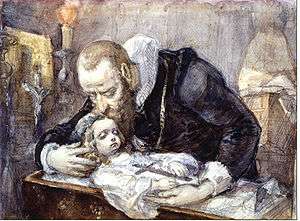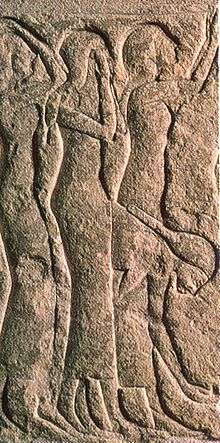Lament

A lament or lamentation is a passionate expression of grief, often in music, poetry, or song form. The grief is most often born of regret, or mourning. Laments can also be expressed in a verbal manner, where the participant would lament about something they regret or someone they've lost, usually accompanied by wailing, moaning and/or crying.[1] Laments constitute some of the oldest forms of writing and examples are present across human cultures.
History

Many of the oldest and most lasting poems in human history have been laments.[2] The Lament for Sumer and Ur dates back at least 4000 years to ancient Sumer, the world's first urban civilization. Laments are present in both the Iliad and the Odyssey, and laments continued to be sung in elegiacs accompanied by the aulos in classical and Hellenistic Greece.[3] Lament elements figure in Beowulf, in the Hindu Vedas, and in ancient Near Eastern religious texts, including the Mesopotamian city laments such as the Lament for Ur and the Jewish Tanakh, (which would later become the Christian Old Testament).
In many oral traditions, both early and modern, the lament has been a genre usually performed by women:[4] Batya Weinbaum made a case for the spontaneous lament of women chanters in the creation of the oral tradition that resulted in the Iliad[5] The material of lament, the "sound of trauma" is as much an element in the Book of Job as in the genre of pastoral elegy, such as Shelley's "Adonais" or Matthew Arnold's "Thyrsis".[6]
The Book of Lamentations or Lamentations of Jeremiah figures in the Old Testament. The Lamentation of Christ (under many closely variant terms) is a common subject from the Life of Christ in art, showing his dead body being mourned after the Crucifixion.
A Lament in The Book of Lamentations or in the Psalms (in the particular Lament/Complaint Psalms of the Tanakh, may be looked at as "a cry of need in a context of crisis when Israel lacks the resources to fend for itself."[7] Another way of looking at it is all the more basic: laments simply being "appeals for divine help in distress".[8] These laments, too, often have a set format: an address to God, description of the suffering/anguish which one seeks relief, a petition for help and deliverance, a curse towards one's enemies, an expression of the belief of ones innocence or a confession of the lack thereof, a vow corresponding to an expected divine response, and lastly, a song of thanksgiving.[9] Examples of a general format of this, both in the individual and communal laments, can be seen in Psalm 3 and Psalm 44 respectively.[10]
The Lament of Edward II, if it is actually written by Edward II of England, is the sole surviving composition of his.
A heroine's lament is a conventional fixture of baroque opera seria, accompanied usually by strings alone, in descending tetrachords.[11] Because of their plangent cantabile melodic lines, evocatively free, non-strophic construction and adagio pace, operatic laments have remained vividly memorable soprano or mezzo-soprano arias even when separated from the emotional pathos of their operatic contexts. An early example is Ariadne's "Lasciatemi morire", which is the only survivor of Claudio Monteverdi's lost Arianna. Francesco Cavalli's operas extended the lamento formula, in numerous exemplars, of which Ciro's "Negatemi respiri" from Ciro is notable.[12]
Other examples include Dido's lament, "When I am laid" (Henry Purcell, Dido and Aeneas), "Lascia ch'io pianga" (Georg Friedrich Handel, Rinaldo), "Caro mio ben" (Tomasso or Giuseppe Giordani). The lament continued to represent a musico-dramatic high point. In the context of opera buffa, the Countess's lament, "Dove sono" comes as a surprise to the audience of Wolfgang Amadeus Mozart's Marriage of Figaro, and in Gioachino Rossini's Barber of Seville, Rosina's plaintive words at her apparent abandonment are followed, not by the expected lament aria, but by a vivid orchestral interlude of storm music. The heroine's lament remained a fixture in romantic opera, and the Marschallin's monologue in Act I of Der Rosenkavalier can be understood as a penetrating psychological lament.[13]
Scottish laments
The purely instrumental lament is a common form in Pìobaireachd music for the Scottish bagpipes. "MacCrimmon's Lament" dates to the Jacobite uprising of 1745. The tune is held to have been written by Donald Ban MacCrimmon, piper to the MacLeods of Dunvegan, who supported the Hanoverians. It is said that Donald Ban, who was killed at Moy in 1746, had an intimation that he would not return.[14]
A well-known Gaelic lullaby is "Griogal Crìdhe" ("Beloved Gregor"). It was composed in 1570 after the execution of Gregor MacGregor by the Campbells. The grief-stricken widow describes what happened as she sings to her child.[15]
"Cumha na Cloine" (Lament for the Children) was composed by Padruig Mòr MacCrimmon in the early 1650s. It is generally held to be based on the loss of seven of MacCrimmon's eight sons to an unknown illness, possibly brought to Skye by a trading vessel. Author Bridget MacKenzie, in Piping Traditions of Argyll, suggests that it refers to the slaughter of the MacLeod's fighting Cromwell's forces at the Battle of Worcester. It may have been inspired by both.[16]
Other Scottish laments include "Lowlands Away", "MacPherson's Rant", and "Hector the Hero".
Musical form
There is a short, free musical form appearing in the Baroque and then again in the Romantic periods, called a lament. It is typically a set of harmonic variations in homophonic texture, wherein the bass descends through a tetrachord, usually one suggesting a minor mode.
See also
- Ballad
- Dirge
- Doina
- Elegy
- endecha Galician lament, subgenre of the planto.
- Kommós
- Lament bass
- Threnody
- King Crimson track "Prince Rupert's Lament" on 1970 album Lizard, an instrumental lament played with electric guitar as lead instrument, and the song "Lament" on 1974 album Starless and Bible Black
- Frederik Magle track Lament on the 2010 album Like a Flame
Notes
- ↑ Piotr Michalowski, trans., Lamentation over the Destruction of Sumer and Ur (Winona Lake, Ind.: Eisenbrauns, 1989), 39–62; cited in Nancy Lee, Lyrics of Lament: From Tragedy to Transformation (Minneapolis: Augsburg Fortress, 2009)
- ↑ Linda M. Austin, "The Lament and the Rhetoric of the Sublime" Nineteenth-Century Literature 53.3 (December 1998:279-306) traces the literary rhetoric evoking a voice crying.
- ↑ Margaret Alexiou, Ritual Lament in Greek Tradition (Cambridge University Press) 1974
- ↑ Alexiou 1974; Angela Bourke, "More in anger than in sorrow: Irish women's lament poetry", in Joan Newlon Radnor, ed., Feminist Messages: Coding in Women's Folk Culture (Urbana: Illinois University Press) 1993:160-82.
- ↑ Batya Weinbaum, "Lament Ritual Transformed into Literature: Positing Women's Prayer as Cornerstone in Western Classical Literature" The Journal of American Folklore 114 No. 451 (Winter 2001:20-39).
- ↑ Austin 1998:280f.
- ↑ Walter Brueggeman, An Unsettling God, (Minneapolis: Fortress Press, 2009) 13
- ↑ Michael D. Coogan, A Brief Introduction to the Old Testament, (Oxford: Oxford University Press, 2009) 370
- ↑ Michael Coogan, A Brief Introduction to the Old Testament (Oxford: Oxford University Press, 2009) 370
- ↑ Michael Coogan, A Brief Introduction to the Old Testament, (Oxford: Oxford University Press, 2009) 370
- ↑ Ellen Rosand, 2007. Opera in Seventeenth-Century Venice (University of California Press), "The lament aria: variations on a theme" pp 377ff.
- ↑ "Negatemi respiri" and several others are noted by Rosand 2007:377f.
- ↑ Called "the Marschallin's Act I lament", in Jeremy Eichler, "Lushly Lamenting the Wages of Time and a Lost Golden Age" opera review in The New York Times March 15, 2005.
- ↑ "MacCrimmon's Lament", Foghlam Alba
- ↑ "Lullabies and Dandlings", Foghlam Alba
- ↑ "Pibroch songs and canntaireachd", Education Scotland
Sources
- Richard Church, The Lamendation of Military Campaigns. PDQ: Steve Ruling, 2000.
- Margaret Alexiou, The ritual lament in Greek tradition. Cambridge: Cambridge University Press, 1974.
- Walter Brueggeman, An Unsettling God. Minneapolis: Fortress Press, 2009
- Michael Coogan, A Brief Introduction to the Old Testament. Oxford: Oxford University Press, 2009
- H. Munro Chadwick, Nora Kershaw Chadwick, The growth of literature (Cambridge: Cambridge University Press, 1932–40), e.g. vol. 2 p. 229.
- Andrew Dalby, Rediscovering Homer (New York: Norton, 2006. ISBN 0-393-05788-7) pp. 141–143.
- Gail Holst-Warhaft, Dangerous voices: women's laments and Greek literature. London: Routledge, 1992. ISBN 0-415-12165-5.
- Nancy C. Lee, Lyrics of Lament: From Tragedy to Transformation. Minneapolis: Fortress, 2010.
- Claus Westermann, Praise and Lament in the Psalms. Westminster: John Knox Press, 1981. ISBN 0-8042-1792-0.
External links
- Greek lament song (Mοιρολόϊ - Moiroloi) from Mani, performed in a funeral
- Traditional Greek lament song (Mοιρολόϊ - Moiroloi) from Epirus